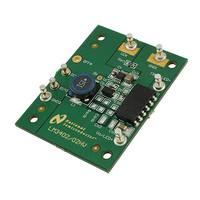LM3402HVEVAL National Semiconductor, LM3402HVEVAL Datasheet - Page 16

LM3402HVEVAL
Manufacturer Part Number
LM3402HVEVAL
Description
BOARD EVALUATION FOR LM3402HV
Manufacturer
National Semiconductor
Series
PowerSmart®r
Specifications of LM3402HVEVAL
Current - Output / Channel
500mA
Outputs And Type
1, Non-Isolated
Voltage - Output
4 V
Features
Dimmable
Voltage - Input
6 ~ 75 V
Utilized Ic / Part
LM3402
Core Chip
LM3402HV
Topology
Buck
Input Voltage
6V To 75V
Dimming Control Type
PWM
Kit Contents
Board
Svhc
No SVHC (15-Dec-2010)
Kit Features
Cycle-by-Cycle Current Limit, Separate PWM Dimming
Lead Free Status / RoHS Status
Lead free / RoHS Compliant
Other names
*LM3402HVEVAL
www.national.com
absolute darkness during DIM mode is also application de-
pendent. It will not affect regular PWM dimming operation.
The fix for this issue is extremely simple. Place a resistor from
the SW pin to ground according to the chart below.
The luminaire designer should ensure that the suggested re-
sistor is effective in eliminating the off-state light output. A
combination of calculations based on LED manufacturer data
and lab measurements over temperature will ensure the best
design.
Transient Protection
Considerations
Considerations need to be made when external sources,
loads or connections are made to the switching converter cir-
cuit due to the possibility of Electrostatic Discharge (ESD) or
Electric Over Stress (EOS) events occurring and damaging
the integrated circuit (IC) device. All IC device pins contain
zener based clamping structures that are meant to clamp
ESD. ESD events are very low energy events, typically less
than 5µJ (microjoules). Any event that transfers more energy
than this may damage the ESD structure. Damage is typically
Number of LEDs
>5
1
2
3
4
5
Resistor Value (kΩ)
150
200
300
20
50
90
FIGURE 6. CS Pin, Transient Path
16
represented as a short from the pin to ground as the extreme
localized heat of the ESD / EOS event causes the aluminum
metal on the chip to melt, causing the short. This situation is
common to all integrated circuits and not just unique to the
LM340X device.
CS PIN PROTECTION
When hot swapping in a load (e.g. test points, load boards,
LED stack), any residual charge on the load will be immedi-
ately transferred through the output capacitor to the CS pin,
which is then damaged as shown in
event due to the residual charge from the load is represented
as V
From measurements, we know that the 8V ESD structure on
the CS pin can typically withstand 25mA of direct current
(DC). Adding a 1kΩ resistor in series with the CS pin, shown
in
pass through the discrete sense resistor rather than the de-
vice. The series resistor limits the peak current that can flow
during a transient event, thus protecting the CS pin. With the
1kΩ resistor shown, a 33V, 49A transient on the LED return
connector terminal could be absorbed as calculated by:
This is an extremely high energy event, so the protection
measures previously described should be adequate to solve
this issue.
Figure
TRANSIENT
7, results in the majority of the transient energy to
.
V = 25mA * 1kΩ + 8V = 33V
I = 33V / 0.67Ω = 49A
Figure 6
20192158
below. The EOS











